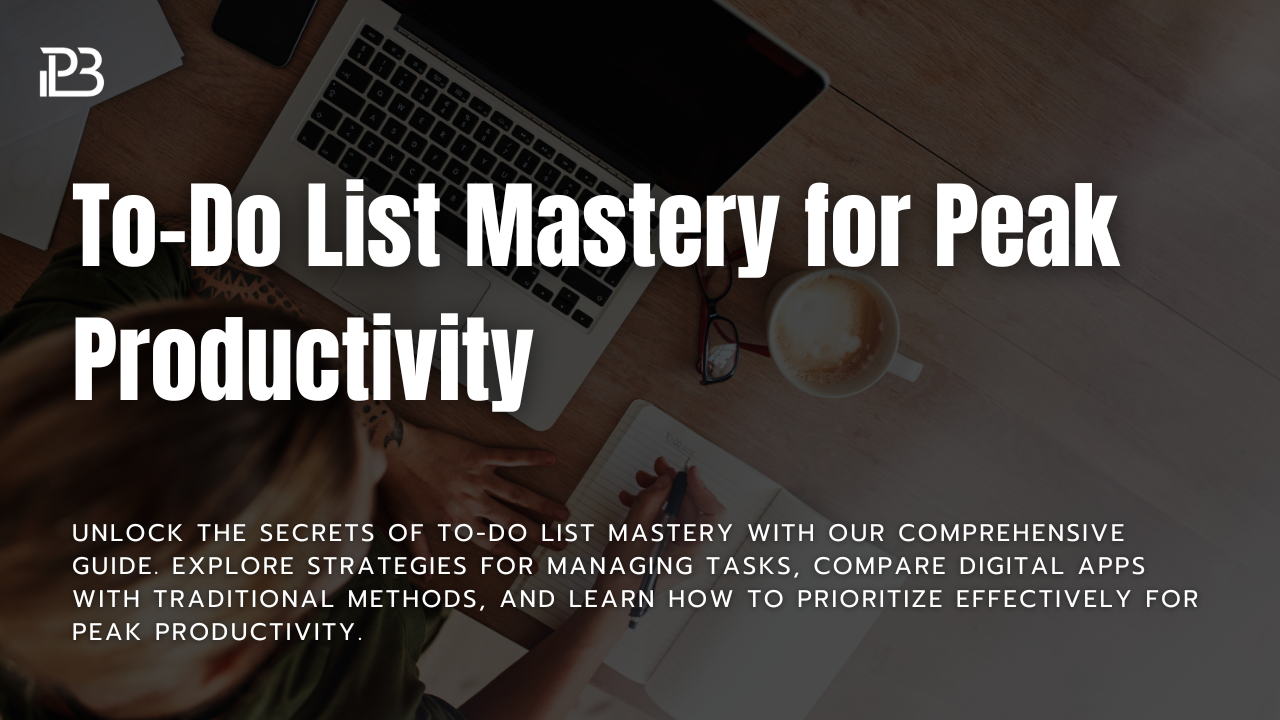Unlock the secrets of to-do list mastery with our comprehensive guide. Explore strategies for managing tasks, compare digital apps with traditional methods, and learn how to prioritize effectively for peak productivity.
In the quest for peak productivity, mastering the art of the to-do list is essential. Whether you’re a busy professional, a student juggling deadlines, or simply trying to organize your personal life, a well-managed to-do list can be the difference between feeling overwhelmed and staying on top of your game. This article explores various strategies for to-do list management, compares digital applications to traditional methods, and offers insights into effective task prioritization.
Table of Contents
The Psychology Behind To-Do Lists
To-do lists are more than just reminders; they’re a psychological tool that can motivate us to take action. The satisfaction of crossing off completed tasks provides a sense of accomplishment and propels us forward. Understanding this can help in crafting a to-do list that not only organizes tasks but also boosts morale and motivation.
Strategies for Managing To-Do Lists
Breaking Down Tasks
Large tasks can seem daunting. Breaking them down into smaller, manageable actions can make them more approachable and reduce procrastination.
Categorization
Organize tasks by category (work, personal, urgent, etc.) to provide clarity and focus. This segmentation helps in balancing different areas of life effectively.
Setting Deadlines
Assign realistic deadlines to tasks to create a sense of urgency. Deadlines help in prioritizing and can prevent tasks from being perpetually postponed.
Digital Apps vs. Traditional Methods
The debate between digital apps and traditional methods for managing to-do lists is ongoing. Here’s a comparison to help you decide which might work best for you.
Digital Apps
- Pros: Accessibility across devices, reminders, and integration with other productivity tools.
- Cons: Potential for digital distraction, reliance on electronic devices.
Traditional Methods
- Pros: Tangibility can enhance memory retention, no electronic distractions, the satisfaction of physically crossing off tasks.
- Cons: Less flexibility in editing, risk of losing physical lists, no automatic reminders.
Highlighting Effective Task Prioritization
The Eisenhower Matrix
This prioritization strategy divides tasks into four categories: urgent and important, important but not urgent, urgent but not important, and neither urgent nor important. This method helps in focusing on what truly matters.
The 80/20 Rule
Also known as the Pareto Principle, it suggests that 20% of your tasks will contribute to 80% of your results. Identifying and focusing on these tasks can significantly enhance productivity.
Daily Top Three
Choosing the top three priorities for the day can ensure focus and progress. This method prevents overwhelm by limiting the number of tasks to concentrate on.
Tips for To-Do List Mastery
- Review and Update Regularly: Your to-do list is a living document. Regularly updating it can keep your priorities in check and adapt to any changes.
- Be Realistic: Overloading your to-do list with more tasks than you can handle can lead to frustration. Be honest about what you can achieve in a day.
- Use a Combination of Methods: Sometimes, a hybrid approach works best. Combining digital tools for reminders and traditional methods for daily planning can harness the strengths of both.
Recommended To-Do List Apps and Devices
In the realm of productivity, finding the right tools can make all the difference. To-do list apps and devices have evolved, offering a range of features to suit different preferences and needs. Here, we spotlight several highly recommended options that stand out for their unique capabilities, user-friendly interfaces, and ability to integrate into various workflows.
Todoist
Todoist shines with its clean, intuitive design and robust functionality. It allows users to create tasks, set deadlines, and categorize them into projects. One of its standout features is the natural language input, making task entry as simple as writing a sentence. With capabilities for collaboration, Todoist is ideal for both personal and team projects. Its cross-platform availability ensures your to-do list is accessible on any device, anytime.
Microsoft To Do
Microsoft To Do, born from the Wunderlist acquisition, offers a seamless integration with Microsoft’s ecosystem, making it a go-to choice for users of Outlook, Office 365, and other Microsoft services. It provides a simple and elegant interface for managing your daily tasks, with features like the My Day list, which encourages prioritizing tasks for the current day. Its integration with Microsoft Outlook allows for the automatic conversion of emails into tasks, streamlining workflow for professionals.
Trello
For those who prefer a visual approach to task management, Trello offers a board-based system that is highly versatile. It’s perfect for project management, allowing users to organize tasks into cards and boards, which can represent different projects or stages of work. With its drag-and-drop interface, custom labels, and checklists, Trello adapts to a wide range of uses, from personal planning to intricate team projects. Its integration with apps like Slack and Google Drive enhances its utility in collaborative settings.
Analog Systems: The Bullet Journal
For enthusiasts of traditional methods, the Bullet Journal offers a customizable and mindful approach to organizing tasks, notes, and events. This analog system uses a simple notebook but stands out for its flexibility and the mindfulness it encourages through manual logging. The Bullet Journal method fosters creativity and allows for a deeply personal touch in task management, making it a beloved choice for those who appreciate pen and paper.
Choosing the Right Tool
When selecting a to-do list app or device, consider factors like:
- Integration with other tools: How well does it play with the apps and services you already use?
- Accessibility: Is it available across the platforms you use (iOS, Android, web, etc.)?
- Features: Does it have the features you need, like reminders, due dates, and collaboration?
- Usability: Is the interface intuitive and user-friendly?
Experimenting with a few options can help you discover which app or method resonates with your personal or professional workflow. Whether digital or analog, the right to-do list tool can empower you to organize your tasks more effectively, streamline your day, and achieve peak productivity.
Related reading:
Conclusion
Mastering your to-do list is a key component of achieving peak productivity. By understanding the psychological benefits, employing effective strategies for management and prioritization, and choosing the right tools for you, your to-do list can become a powerful ally in navigating the complexities of daily life. Whether you prefer the tactile nature of traditional methods or the convenience of digital apps, the ultimate goal is to create a system that works for you, helping you to manage your tasks efficiently and boost your productivity to new heights.





Pingback: Building Wealth: Inspirational Quotes to Guide Your Financial Freedom Journey - Project Lion's Blueprint